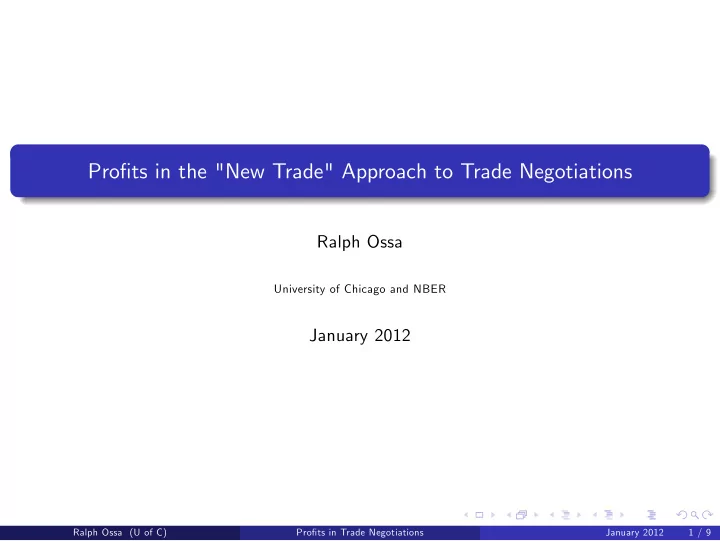

Pro…ts in the "New Trade" Approach to Trade Negotiations Ralph Ossa University of Chicago and NBER January 2012 Ralph Ossa (U of C) Pro…ts in Trade Negotiations January 2012 1 / 9
Overview The terms-of-trade theory has long been the dominant theory of trade negotiations: Johnson (1952), Grossman and Helpman (1995), Bagwell and Staiger (1999), ... Recently, a number of "new trade" alternatives have emerged: Ossa (2011a), Mrazova (2011), Bagwell and Staiger (2011), ... In this paper, I highlight two advantages of taking such a "new trade" approach: It allows for a focus on producer interests and lends itself to quantitative work Ralph Ossa (U of C) Pro…ts in Trade Negotiations January 2012 2 / 9
Contribution To this end, I consider a version of my quantitative analysis in Ossa (2011a): I rule out free entry which gives rise to pro…t shifting e¤ects I keep the analysis deliberately simple to clearly highlight the novel elements: I shut o¤ terms-of-trade e¤ects and allow only for aggregate trade policy These simpli…cations imply that the quantitative results are only illustrative: I have recently provided more de…nite results in Ossa (2011b) Ralph Ossa (U of C) Pro…ts in Trade Negotiations January 2012 3 / 9
Equilibrium conditions in levels De…nition � � Π i , G i , X i , T ij For given tari¤s, an equilibrium is a set of such that Π i = 1 J σ ∑ j = 1 T ij � � 1 � σ � � 1 J 1 � σ ∑ G j = i = 1 n i p i θ ij τ ij J X j = L j + ∑ i = 1 t ij T ij + Π j � TB j � � 1 � σ G σ � 1 T ij = n i τ � σ p i θ ij µ X j ij j This is in terms of many unknown parameters! Ralph Ossa (U of C) Pro…ts in Trade Negotiations January 2012 4 / 9
Equilibrium conditions in changes De…nition n o Π i , b b G i , b X i , b For given tari¤ changes, an equilibrium is a set of T ij such that Π i = ∑ J b j = 1 α ij b T ij � � 1 � σ � �b 1 J b 1 � σ ∑ G j = i = 1 β ij τ ij X j = γ j + ∑ J b i = 1 δ ij t 0 ij b T ij + ε j b Π j � � σ � � σ � 1 b �b b b T ij = τ ij G j X j This is in terms of µ , σ , and observable tari¤s and trade ‡ows only! Ralph Ossa (U of C) Pro…ts in Trade Negotiations January 2012 5 / 9
US optimal tari¤s Table 1 - Welfare e¤ects of US optimal tari¤s Overall Welfare Consumer Surplus Producer Surplus Tari¤ Revenue ROW -0.21% 0.00% -0.21% 0.00% EU -0.07% 0.00% -0.07% 0.00% Brazil -0.10% 0.00% -0.09% 0.00% China -0.29% 0.00% -0.29% 0.00% India -0.07% 0.00% -0.07% 0.00% Japan -0.08% 0.00% -0.08% 0.00% US 0.15% -0.45% 0.31% 0.29% Notes: US optimal tari¤s average 21 percent and vary little across trading partners. I use trade and tari¤ data for the year 2004 and assume µ = 0 . 188 and σ = 4 . 6 following Dekle et al (2007). In Ossa (2011b), I …nd that US optimal tari¤s average 66 percent, the US gains 2.6 percent, and other countries lose 1.6 percent on average. Ralph Ossa (U of C) Pro…ts in Trade Negotiations January 2012 6 / 9
World Nash tari¤s Table 2 - Welfare e¤ects of world Nash tari¤s Overall Welfare Consumer Surplus Producer Surplus Tari¤ Revenue ROW -0.46% -0.56% -0.23% 0.34% EU -0.12% -0.33% -0.01% 0.20% Brazil -0.24% -0.17% -0.14% 0.07% China -0.79% -1.01% -0.50% 0.72% India -0.23% -0.12% -0.15% 0.05% Japan -0.20% -0.20% -0.13% 0.13% US -0.03% -0.45% 0.13% 0.29% Notes: World Nash tari¤s average 21 percent and vary little across trading partners. I use trade and tari¤ data for the year 2004 and assume µ = 0 . 188 and σ = 4 . 6 following Dekle et al (2007). In Ossa (2011b), I …nd that world Nash tari¤s average 63 percent and the welfare losses average 4.1 percent. Ralph Ossa (U of C) Pro…ts in Trade Negotiations January 2012 7 / 9
Multilateral trade negotiations Table 3 - Welfare e¤ects of worldwide free trade Overall Welfare Consumer Surplus Producer Surplus Tari¤ Revenue ROW -0.05% 0.41% -0.08% -0.38% EU 0.08% 0.06% 0.08% -0.06% Brazil -0.08% 0.38% -0.15% -0.31% China 0.23% 0.36% 0.23% -0.36% India -0.11% 0.42% -0.20% -0.33% Japan 0.10% 0.02% 0.01% -0.02% US 0.04% 0.08% 0.04% -0.08% Notes: I use trade and tari¤ data for the year 2004 and assume µ = 0 . 188 and σ = 4 . 6 following Dekle et al (2007). Ralph Ossa (U of C) Pro…ts in Trade Negotiations January 2012 8 / 9
Conclusion The main goal of this paper was to highlight two advantages of adopting a "new trade" approach to trade negotiations First, it allows for a view of trade negotiations in which producer interests play a prominent role Second, it lends itself naturally to quantitative analyses of non-cooperative and coop- erative trade policy In my view, these advantages point to numerous exciting opportunities for further theoretical, empirical, and quantitative work Ralph Ossa (U of C) Pro…ts in Trade Negotiations January 2012 9 / 9
Recommend
More recommend